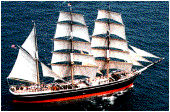
The Star of India
|
|
The Star of India |
Euterpe was a full-rigged ship and would remain so until 1901, when the Alaska Packers Association changed the rigging to a barque, her present rig. She began her sailing life with two near-disastrous voyages to India. On her first trip she suffered a collision and a mutiny. On her second trip, a cyclone caught Euterpe in the Bay of Bengal, and with her topmasts cut away, she barely made port. Shortly afterward, her first captain died on board and was buried at sea.
After such a hard luck beginning, Euterpe settled down and made four more voyages to India as a cargo ship. In 1871 she was purchased by the Shaw Savill line of London and embarked on 25 years of hauling emigrants to New Zealand, sometimes also touching Australia, California and Chile. She made 21 circumnavigations in this service, some of them lasting up to a year. It was rugged voyaging, with the little iron ship battling through terrific gales, "labouring and rolling in a most distressing manner," according to her log.
Sailors caught swearing or using improper language could lose a full day's pay. For not bringing up, opening out, and airing bedding when ordered, they would lose half a day's pay. Three day's pay would be lost for bringing or having "spiritous liquors" on board.